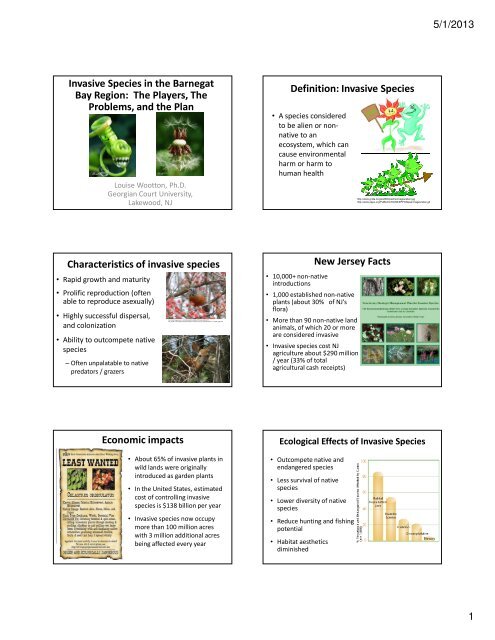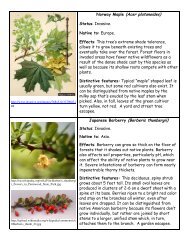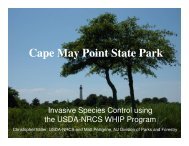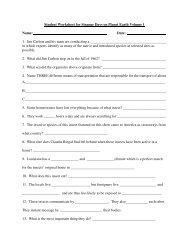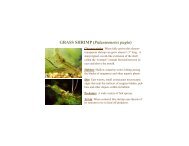Invasive Species in the Barnegat Bay Region - Georgian Court ...
Invasive Species in the Barnegat Bay Region - Georgian Court ...
Invasive Species in the Barnegat Bay Region - Georgian Court ...
Create successful ePaper yourself
Turn your PDF publications into a flip-book with our unique Google optimized e-Paper software.
http://2.bp.blogspot.com/_AiHL6WpaVn8/SxKMMuPjPII/AAAAAAAAET0/-<br />
Mh_3HCW_YA/s1600/4+American+Rob<strong>in</strong>,+Frankl<strong>in</strong>+County,+OH+December+14,+2008+(29).JPG<br />
5/1/2013<br />
<strong>Invasive</strong> <strong>Species</strong> <strong>in</strong> <strong>the</strong> <strong>Barnegat</strong><br />
<strong>Bay</strong> <strong>Region</strong>: The Players, The<br />
Problems, and <strong>the</strong> Plan<br />
Louise Wootton, Ph.D.<br />
<strong>Georgian</strong> <strong>Court</strong> University,<br />
Lakewood, NJ<br />
Def<strong>in</strong>ition: <strong>Invasive</strong> <strong>Species</strong><br />
• A species considered<br />
to be alien or nonnative<br />
to an<br />
ecosystem, which can<br />
cause environmental<br />
harm or harm to<br />
human health<br />
http://www.grida.no/geo2000/pacha/images/alien.jpg<br />
http://www.eppo.org/PUBLICATIONS/EPPONews/images/alien.gif<br />
Characteristics of <strong>in</strong>vasive species<br />
• Rapid growth and maturity<br />
• Prolific reproduction (often<br />
able to reproduce asexually)<br />
• Highly successful dispersal,<br />
and colonization<br />
• Ability to outcompete native<br />
species<br />
– Often unpalatable to native<br />
predators / grazers<br />
• 10,000+ non-native<br />
<strong>in</strong>troductions<br />
New Jersey Facts<br />
• 1,000 established non-native<br />
plants (about 30% of NJ’s<br />
flora)<br />
• More than 90 non-native land<br />
animals, of which 20 or more<br />
are considered <strong>in</strong>vasive<br />
• <strong>Invasive</strong> species cost NJ<br />
agriculture about $290 million<br />
/ year (33% of total<br />
agricultural cash receipts)<br />
Economic impacts<br />
• About 65% of <strong>in</strong>vasive plants <strong>in</strong><br />
wild lands were orig<strong>in</strong>ally<br />
<strong>in</strong>troduced as garden plants<br />
• In <strong>the</strong> United States, estimated<br />
cost of controll<strong>in</strong>g <strong>in</strong>vasive<br />
species is $138 billion per year<br />
• <strong>Invasive</strong> species now occupy<br />
more than 100 million acres<br />
with 3 million additional acres<br />
be<strong>in</strong>g affected every year<br />
Ecological Effects of <strong>Invasive</strong> <strong>Species</strong><br />
• Outcompete native and<br />
endangered species<br />
• Less survival of native<br />
species<br />
• Lower diversity of native<br />
species<br />
• Reduce hunt<strong>in</strong>g and fish<strong>in</strong>g<br />
potential<br />
• Habitat aes<strong>the</strong>tics<br />
dim<strong>in</strong>ished<br />
1
5/1/2013<br />
Methods of Spread<br />
• Intentional <strong>in</strong>troduction<br />
– Stabilize roadsides<br />
• Multiflora rose<br />
– Ornamental<br />
• Purple loosestrife<br />
Methods of Spread<br />
• Accidental Introduction<br />
– Carried <strong>in</strong>to area <strong>in</strong> pack<strong>in</strong>g material, on planes or<br />
o<strong>the</strong>r vehicles<br />
Methods of Spread<br />
• Planes, tra<strong>in</strong>s and automobiles… and hikers too!<br />
• Garden escapees<br />
Methods of Spread<br />
– University of Wash<strong>in</strong>gton study:<br />
Planted 19 wildflower seed mix<br />
packets. All conta<strong>in</strong>ed from 3 - 13<br />
species identified as <strong>in</strong>vasive <strong>in</strong><br />
some part of North America<br />
Methods of Spread<br />
• Ornamental Rocks and Fill<br />
2
5/1/2013<br />
What are <strong>the</strong> Ma<strong>in</strong> Problem<br />
<strong>Species</strong> <strong>in</strong> this Area<br />
• Emailed Monmouth and Ocean<br />
County Park officials<br />
• Asked for a list of “most hated”<br />
<strong>in</strong>vasives<br />
• 4 detailed responses<br />
– Ken Thoman, Monmouth County Park<br />
Super<strong>in</strong>tendent<br />
– Kev<strong>in</strong> Holcomb, Wildlife Biologist<br />
Forsy<strong>the</strong> National Park<br />
– Cynthia L. Coritz, Bass River State Forest<br />
– Robert Auermuller Wharton State Park<br />
Super<strong>in</strong>tendent<br />
http://york.extension.psu.edu/NResources/Images/Ber%20th%20<strong>in</strong>fst.jpg<br />
http://www.newfs.org/protect/<strong>in</strong>vasive-plants/photo-gallery/Berberis%20thunbergii,%20Leslie%20J.%20Mehrhoff.jpg/image_preview<br />
Garden Escapees<br />
Japanese Barberry (Berberis thunbergii)<br />
• Decorative shrub valued for its<br />
attractive foliage and colorful<br />
berries<br />
• Each plant makes many seeds<br />
which are transported by birds<br />
to surround<strong>in</strong>g habitats.<br />
• Overgrows native shrubs and<br />
changes soil pH to make it less<br />
hospitable to native species<br />
Garden Escapees<br />
Ch<strong>in</strong>ese and Japanaese Wisterias<br />
(Wisteria s<strong>in</strong>ensis, W. floribunda)<br />
• Hard woody v<strong>in</strong>es tw<strong>in</strong>e tightly around<br />
host tree trunks and branches girdl<strong>in</strong>g<br />
and kill<strong>in</strong>g <strong>the</strong>m<br />
• V<strong>in</strong>es can form dense thickets that<br />
smo<strong>the</strong>r and shade out native<br />
vegetation by numerous above-ground<br />
stems that develop roots and shoots<br />
The scope of <strong>the</strong> barberry <strong>in</strong>vasion <strong>in</strong> this park is particularly<br />
easy to see <strong>in</strong> early spr<strong>in</strong>g<br />
• Negatively impacts wildlife dependent<br />
on native vegetation for forage, nest<strong>in</strong>g,<br />
and cover<br />
http://farm4.static.flickr.com/3237/2939721819_ae496c1c2a.jpg<br />
Garden Escapees<br />
Yellow (Asian) Honeysuckles<br />
Lonicera spp.<br />
• Heady fragrance of <strong>the</strong>se<br />
ornamental v<strong>in</strong>es makes<br />
<strong>the</strong>m a common choice for<br />
gardens<br />
• Birds spread seeds <strong>in</strong>to<br />
surround<strong>in</strong>g wild areas<br />
where v<strong>in</strong>es overgrow and<br />
choke native vegetation<br />
Wisteria kill<strong>in</strong>g a p<strong>in</strong>e<br />
http://nyis.<strong>in</strong>fo/plants/Honeysuckle.aspx<br />
3
5/1/2013<br />
Garden Escapees<br />
Non-native Bamboos<br />
(Bambusa, Phyllostachys,<br />
Psuedosassa)<br />
• Evergreen and hardy to -25 F,<br />
<strong>the</strong>se bamboos produce culms<br />
each season that grow to more<br />
than 30' <strong>in</strong> just weeks<br />
• Clump<strong>in</strong>g bamboos not AS<br />
bad. Runn<strong>in</strong>g = very bad!<br />
Honeysuckle overgrow<strong>in</strong>g native trillium<br />
http://shltrip.com/sitebuilder/images/4s_bamboo_forest_<strong>in</strong>_Rutgers_G<br />
arden_IMG_9680-982x744.jpg<br />
Garden Escapees<br />
Asian (or Oriental) Bittersweet<br />
(Celastrus orbiculata)<br />
• Gardeners like it for its fast<br />
growth and attractive fruit<br />
• Aggressive <strong>in</strong>vader.<br />
• Seeds are spread by birds to<br />
surround<strong>in</strong>g wild areas where it<br />
overgrows o<strong>the</strong>r plants<br />
smo<strong>the</strong>r<strong>in</strong>g <strong>the</strong>m and girdl<strong>in</strong>g<br />
tree trunks.<br />
Purple loosestrife (Lythrum<br />
salicaria)<br />
• Showy flowers make it<br />
gardeners’ favorite<br />
• Mature plant produces 2-3<br />
million seeds per year.<br />
Garden Escapees<br />
• When reach wetland habitats<br />
grow rapidly, outcompet<strong>in</strong>g<br />
native grasses, sedges and<br />
reduc<strong>in</strong>g habitat for waterfowl<br />
Periw<strong>in</strong>ke (V<strong>in</strong>ca m<strong>in</strong>or)<br />
• Forms dense carpet that<br />
excludes o<strong>the</strong>r species<br />
Garden Escapees<br />
• Grows most vigorously <strong>in</strong><br />
moist soil with only partial sun,<br />
but it can grow <strong>in</strong> deepest<br />
shade, even <strong>in</strong> poor soil<br />
http://pics.davesgarden.com/pics/Equilibrium_1124078074_450.jpg<br />
http://www.hiltonpond.org/images/V<strong>in</strong>caM<strong>in</strong>orSpr<strong>in</strong>g01.jpg<br />
4
5/1/2013<br />
English Ivy (Hedera helix)<br />
• As it climbs it engulfs and<br />
kills tree branches by<br />
block<strong>in</strong>g light from<br />
reach<strong>in</strong>g tree’s leaves<br />
• Extra weight can make<br />
trees more likely to lean<br />
and fall<br />
Garden Escapees<br />
<strong>Invasive</strong> Weeds<br />
Mile-a-m<strong>in</strong>ute weed<br />
(Polygonum perfoliatum)<br />
• Dist<strong>in</strong>ctive triangular blue green<br />
leaves, and curved sp<strong>in</strong>es on<br />
reddish green stems.<br />
• Seeds transported by birds and<br />
mammals<br />
• V<strong>in</strong>e overgrows and outcompetes<br />
native vegetation<br />
• Can br<strong>in</strong>g down branches or<br />
whole trees with its weight<br />
http://www.massnrc.org/pests/pestFAQsheets/popup_code/mileam<strong>in</strong>utefig01.htm<br />
http://www.ec.gc.ca/eee-ias/4612AC81-3CB4-4AC4-BCE5-3D5845DEFF1B/Phragmites%20australis.JPG<br />
<strong>Invasive</strong> Weeds<br />
Common Reed (Phragmites<br />
australis)<br />
• Forms dense stands up to 15’ tall<br />
• Bushy flowers ripen from brown to<br />
grey and ga<strong>in</strong> a fluffy appearance<br />
from hairs on seeds<br />
• Once <strong>in</strong> marsh, or disturbed<br />
habitat, rapidly forms monoculture,<br />
crowd<strong>in</strong>g out native plants,<br />
chang<strong>in</strong>g hydrology, alter<strong>in</strong>g<br />
wildlife habitat and <strong>in</strong>creas<strong>in</strong>g fire<br />
potential<br />
<strong>Invasive</strong> Weeds<br />
Garlic Mustard (Alliaria petiolata)<br />
• Leaves and stems emit dist<strong>in</strong>ctive<br />
garlic odor when crushed<br />
• Slender white taproot with<br />
dist<strong>in</strong>ctive “S” shape at top.<br />
• Seeds are dispersed on fur of<br />
mammals.<br />
• It spreads rapidly <strong>in</strong> woodland<br />
habitats, displac<strong>in</strong>g native<br />
wildflowers<br />
• Primary spread is via human<br />
transport (hik<strong>in</strong>g, mow<strong>in</strong>g).<br />
http://www.phragmites.crad.ulaval.ca/Images/ACCUEIL.jpg<br />
http://commons.wikimedia.org/wiki/File:Alliaria_petiolata.png<br />
<strong>Invasive</strong> Weeds<br />
Japanese Stilt Grass<br />
(Microstegium vim<strong>in</strong>eum)<br />
• Recognized by its lime-green<br />
color and sh<strong>in</strong>y, slightly offcenter<br />
midrib<br />
• Forms dense monocultures that<br />
out-compete nearly all o<strong>the</strong>r<br />
plant life on forest floor, even <strong>in</strong><br />
undisturbed habitats<br />
<strong>Invasive</strong> Weeds<br />
Japanese Knotweed (Polygonum<br />
cuspidatum)<br />
• Dist<strong>in</strong>ctive hollow red-t<strong>in</strong>ged<br />
stems, heart shaped leaves and,<br />
<strong>in</strong> summer, lacy strands of t<strong>in</strong>y,<br />
white flowers<br />
• An aggressive <strong>in</strong>vader, it is<br />
particularly problematic along<br />
rivers and stream banks where it<br />
forms dense stands and<br />
outcompetes native vegetation<br />
http://images.nbii.gov/ESellers/D_med-res/bansPicture%20044.jpg<br />
5
5/1/2013<br />
http://www.flickr.com/photos/plant_diversity/3768272782/<br />
<strong>Invasive</strong> Weeds<br />
Spotted Knapweed (Centaurea<br />
maculosa)<br />
• Dist<strong>in</strong>ctive black tips on flower<br />
bracts give species its name.<br />
• Produces huge number of seeds<br />
and is spread<strong>in</strong>g rapidly <strong>in</strong> NJ and<br />
beyond.<br />
• Grows <strong>in</strong> variety of habitats<br />
where it outcompetes native<br />
species<br />
• Also harms soil and water by<br />
<strong>in</strong>creas<strong>in</strong>g erosion, surface<br />
runoff, and stream<br />
sedimentation<br />
http://upload.wikimedia.org/wikipedia/commons/4/4a/Cirsium_arvense_0.10_R.jpg<br />
http://commons.wikimedia.org/wiki/File:Canada_thistle_cirsium_arvense_144a.JPG<br />
<strong>Invasive</strong> Weeds<br />
Canada Thistle (Cirsium arvense)<br />
• 1 – 4 feet tall with sp<strong>in</strong>y, lobed<br />
leaves and many small, purplish<br />
flower heads<br />
• Highly <strong>in</strong>vasive, it outcompetes<br />
native plants <strong>in</strong> open habitats such<br />
as barrens, sand dunes and<br />
meadows<br />
Asiatic Sand Sedge<br />
• Lower stature<br />
• Much denser growth pattern<br />
• Outcompetes native plants<br />
• Not eaten by native animals<br />
• Forms lower, wider dunes<br />
<strong>Invasive</strong> Aquatics<br />
Eurasian water-milfoil (Myriophyllum<br />
spicatum)<br />
• Grows mostly <strong>in</strong> lakes and ponds<br />
• Starts grow<strong>in</strong>g earlier <strong>in</strong> spr<strong>in</strong>g than<br />
native aquatic plants,<br />
• Quickly forms dense canopy that<br />
outcompetes surround<strong>in</strong>g vegetation<br />
• Lower food value to waterfowl than<br />
native plants<br />
• Supports fewer <strong>in</strong>vertebrates so affects<br />
fish too<br />
• Water quality and dissolved oxygen<br />
decl<strong>in</strong>es due to decay of thick vegetation<br />
Curly-leaf pondweed<br />
(Potamogeton crispus)<br />
<strong>Invasive</strong> Aquatics<br />
• Usually first macrophyte to<br />
emerge <strong>in</strong> spr<strong>in</strong>g, but dies back<br />
by July<br />
• Capable of rapid growth and<br />
spread<br />
• Can displace native species,<br />
reduce biodiversity, impede<br />
recreational activities and<br />
decrease water quality<br />
<strong>Invasive</strong> Animals of <strong>the</strong> <strong>Barnegat</strong><br />
<strong>Region</strong><br />
Green crab<br />
Asian shore crab<br />
Mute Swan<br />
Harlequ<strong>in</strong> Ladybug<br />
Beetle<br />
Starl<strong>in</strong>g<br />
Japanese Beetle<br />
6
5/1/2013<br />
INVASIVE<br />
SPECIES<br />
Prevention is <strong>the</strong><br />
best way to reduce<br />
threats from <strong>in</strong>vasive<br />
species, because<br />
once <strong>the</strong>y arrive it is<br />
almost impossible to<br />
slow <strong>the</strong>ir spread.<br />
Status and Trends <strong>in</strong> State <strong>Invasive</strong> <strong>Species</strong> Policy: 2002-2009 (free download available from<br />
http://www.elistore.org)<br />
NJ <strong>Invasive</strong> <strong>Species</strong> Legislation<br />
• The New Jersey Department of Agriculture has lists of<br />
prohibited and restricted seeds<br />
http://www.nj.gov/agriculture/divisions/pi/prog/noxious.html<br />
e.g. PROHIBITED WEED SEED<br />
The follow<strong>in</strong>g seeds are not allowed <strong>in</strong> agricultural, flower, tree, shrub or lawn<br />
and turf seed:<br />
– B<strong>in</strong>dweed - Convolvulus arvensis<br />
– Hedge b<strong>in</strong>dweed - Convolvulus sepium<br />
– Quackgrass - Agropyron repens<br />
– Canada thistle - Cirsium arvense<br />
– Horse nettle - Solanum carol<strong>in</strong>ense<br />
– Purple loosestrife--Lythrum salicaria L. (added <strong>in</strong> 2013)<br />
• NJ also has a recommended “Do not plant” list:<br />
http://www.njisst.org/files/DoNotPlantList.pdf<br />
New Jersey Lags Many O<strong>the</strong>r States <strong>in</strong><br />
<strong>Invasive</strong> <strong>Species</strong> Legislation<br />
Status and Trends <strong>in</strong> State <strong>Invasive</strong> <strong>Species</strong> Policy: 2002-2009 (free download available from<br />
http://www.elistore.org)<br />
Municipal Ord<strong>in</strong>ances<br />
• <strong>Invasive</strong> <strong>Species</strong> Ord<strong>in</strong>ances <strong>in</strong> NJ. Wall, Brick, Lacey and Toms River<br />
– All persons must control <strong>the</strong> growth of <strong>in</strong>vasive plants. Failure to control <strong>the</strong><br />
spread of such vegetation beyond <strong>the</strong> boundaries of a resident's property is a<br />
violation of this chapter.<br />
– All places and premises <strong>in</strong> <strong>the</strong> Township [] shall be subject to <strong>in</strong>spection by <strong>the</strong><br />
enforc<strong>in</strong>g officer. Such <strong>in</strong>spections shall be performed by such person, persons<br />
or agency duly authorized and appo<strong>in</strong>ted by <strong>the</strong> Township []. Such <strong>in</strong>spection<br />
shall be made if that official has reason to believe that any section of this<br />
chapter is be<strong>in</strong>g violated.<br />
– Whenever an <strong>in</strong>vasive plant as def<strong>in</strong>ed by this chapter is found on any plot of<br />
land, lot or any o<strong>the</strong>r premises or place, a violation shall be given to <strong>the</strong> owner,<br />
<strong>in</strong> writ<strong>in</strong>g, to remove or abate <strong>the</strong> same with<strong>in</strong> such time as shall be specified<br />
<strong>the</strong>re<strong>in</strong> (recommend time <strong>in</strong> years, due to difficulty of remov<strong>in</strong>g bamboo).<br />
– Examples <strong>in</strong>clude but are not limited to bamboo (spread<strong>in</strong>g or runn<strong>in</strong>g type),<br />
ragweed, multi flora rose, kudzu-v<strong>in</strong>e and poison ivy or oak.<br />
Municipal Ord<strong>in</strong>ances<br />
• Survey by <strong>the</strong> State League of Municipalities of a<br />
representative sample of towns <strong>in</strong> New Jersey<br />
showed ¼ of municipalities to have someth<strong>in</strong>g about<br />
<strong>in</strong>vasive plant species <strong>in</strong> <strong>the</strong>ir town codes (30 / 120<br />
towns surveyed)<br />
• E.g. Margate’s Land Use Ord<strong>in</strong>ance:<br />
– 6. Plant<strong>in</strong>gs of bamboo are not permitted, as <strong>the</strong>y become<br />
harmful to foundations, o<strong>the</strong>r plants, and potentially water<br />
and sewer pipes.<br />
7
5/1/2013<br />
What Else Can You Do to Help<br />
Volunteer Opportunities to Combat <strong>Invasive</strong> Plants<br />
• Contact <strong>the</strong> Central New Jersey <strong>Invasive</strong> <strong>Species</strong><br />
Strike team and ask about volunteer opportunities <strong>in</strong><br />
your area: http://www.fohvos.org/CJISST.html<br />
• Insert keyword “<strong>in</strong>vasive” at Volunteer New Jersey’s<br />
website to f<strong>in</strong>d more opportunities <strong>in</strong> your area<br />
https://volunteer.united-eway.org/volunteernewjersey/volunteer/state/<br />
Where to Buy Native Plants<br />
P<strong>in</strong>elands Nursery<br />
323 Island Road<br />
Columbus, New Jersey 08022<br />
Tel: (609) 291-9486,(800) 667-2729<br />
Fax: (609) 298-8939<br />
Opens for retail bus<strong>in</strong>ess <strong>in</strong> spr<strong>in</strong>g and fall<br />
http://www.p<strong>in</strong>elandsnursery.com/<br />
Russell Gardens (Wholesale)<br />
PO Box 702<br />
Richboro, PA 18954<br />
215 322-4799<br />
http://russellwholesale.com/zencart<br />
Cicconi Farms<br />
1005 Farm Road<br />
Jackson, NJ 08527<br />
732 363-1420<br />
http://www.cicconifarms.com/<br />
Toadshade Wildflower Farm<br />
53 Everittstown Road<br />
Frenchtown, NJ 08825<br />
908 996-7500<br />
http://www.toadshade.com/<br />
8


